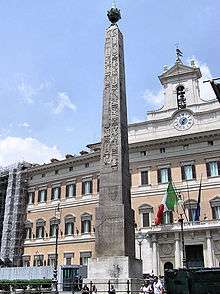Obelisk of Montecitorio

The Obelisk of Montecitorio (Italian: Obelisco di Montecitorio), also known as Solare, is an ancient Egyptian, red granite obelisk of Psammetichus II (595-589 BC) from Heliopolis. Brought to Rome with the Flaminio Obelisk in 10 BC by the Roman Emperor Augustus to be used as the gnomon of the Solarium Augusti, it is now in the Piazza Montecitorio. It is 21.79 metres (71 ft) high, and 33.97 metres (111 ft) including the base and the globe.
History
First construction
Augustus erected it as the gnomon of the Solarium Augusti, his giant sundial (or horologium) in the Campus Martius. The meridian, worked out by the mathematician Facondius Novus, was placed in the center of a surface measuring 160 by 75 metres (525 by 246 ft), constructed from slabs of travertine, on which a quadrant was marked out with bronze letters, with indications of the hours, months, seasons and signs of the zodiac. Besides its function as a solar clock, the obelisk was oriented in such manner so as to cast its shadow on the nearby Ara Pacis on 23 September, Augustus's birthday, which coincided with the autumnal equinox.
A detailed description that gives us the typology, appearance and formal operating procedure of this imposing solar meridian is supplied from Pliny the Elder (Naturalis Historia 36, 71-72).[1]
The inscription written on two sides of the obelisk's base runs as follows:
- Imp. Caesar divi fil. / Augustus / pontifex maximus / imp. XII cos XI trib pot XIV / Aegypto in potestatem / populi romani redacta / soli donum dedit.[2]
However, according to Pliny, the original horologic stopped working 30 years after its construction (that is, by the 40s AD).[3]

Later history
Between the 9th and 11th centuries, probably because of fire, earthquake (perhaps the earthquake of 849) or war (e.g. during the siege of Rome of 1084 by Robert Guiscard), the obelisk collapsed and then, progressively, became buried. Pope Sixtus V (1520–1590) made some attempts to repair and raise the obelisk, reassembling some pieces that had been found in 1502 in a cellar off the "Largo dell'Impresa", the present Piazza del Parlamento. After this fruitless attempt, some traces of the meridian were recovered during the pontificate of Benedict XIV in 1748, who found parts of it under the main entrance of Piazza del Parlamento 3, sited just as in Pliny's description. The obelisk and the meridian were not originally located in the position in which they were re-erected by the popes, but in the space behind the Curia innocenziana (now called Palazzo Montecitorio). Under the cellar of a stable on a street in the Campus Martius, a piece of the meridian was excavated, with the markings for various months in Greek letters set into the travertine slabs. Another fragment was hypothesized to be contained in the mosaic still visible in the foundation of the Church of San Lorenzo in Lucina.

From 1789 to 1792, Pope Pius VI carried out intensive works to repair the obelisk, which was later raised and restored as a solar clock. The direction of the restoration work was entrusted to the architect Giovanni Antinori, who restored the obelisk using granite from the Column of Antoninus Pius. This column's base, with its famous relief showing the Solar obelisk held as a symbol of the Campus Martius regio by a personification of the Campus, is still preserved in the Vatican Museums.
In the new layout of Piazza Montecitorio (inaugurated on 7 June 1998), a new meridian was traced on the pavement in honor of Augustus's meridian, pointing towards the main entrance of the palazzo. Unfortunately, the shadow of the obelisk does not point precisely in that direction, and its gnomonic function is definitively lost.
See also
Notes
- ↑ is autem obeliscus, quem divus Augustus in circo magno statuit, excisus est a rege Psemetnepserphreo, quo regnante Pythagoras in Aegypto fuit, LXXXV pedum et dodrantis praeter basim eiusdem lapidis; is vero, quem in campo Martio, novem pedibus minor, a Sesothide. inscripti ambo rerum naturae interpretationem Aegyptiorum philosophia continent. — Ei, qui est in campo, divus Augustus addidit mirabilem usum ad deprendendas solis umbras dierumque ac noctium ita magnitudinis, strato lapide ad longitudinem obelisci, cui par fieret umbra brumae confectae die sexta hora paulatimque per regulas, quae sunt ex aere inclusae, singulis diebus decresceret ac rursus augeresceret, digna cognitu res, ingenio Facundi Novi mathematici. is apici auratam pilam addidit, cuius vertice umbra colligeretur in se ipsam, alias enormiter iaculante apice, ratione, ut ferunt, a capite hominis intellecta.
- ↑ The emperor, Caesar, son of the deified Julius Caesar, August, pontifex maximus, proclaimed imperator for the twelfth time, consul for the eleventh time, holding tribunician power for the fourteenth time, having subdued Egypt to the power of the Roman people, gave this gift to the sun.
- ↑ haec observatio XXX iam fere annis non congruit, sive solis ipsius dissono cursu et caeli aliqua ratione mutato sive universa tellure a centro suo aliquid emota (ut deprehendi et aliis in locis accipio) sive urbis tremoribus ibi tantum gnomone intorto sive inundationibus Tiberis sedimento molis facto, quamquam ad altitudinem inpositi oneris in terram quoque dicuntur acta fundamenta. (Naturalis Historia, XXXVI, 73).
References
| Wikimedia Commons has media related to Montecitorio obelisk. |
- Franco Zagari, Piazza Montecitorio. Progetto di riqualificazione ambientale 1996-1998, (Camera dei Deputati e Comune di Roma), Roma 1998.
- Model, diagrams, and photographs of the Obelisk of Montecitorio
Coordinates: 41°54′02″N 12°28′43″E / 41.9006°N 12.4787°E